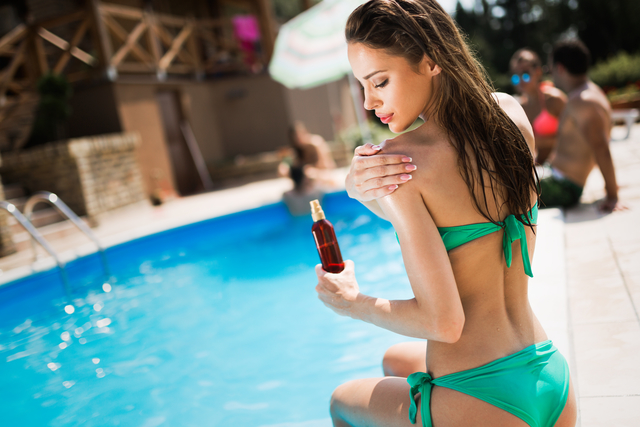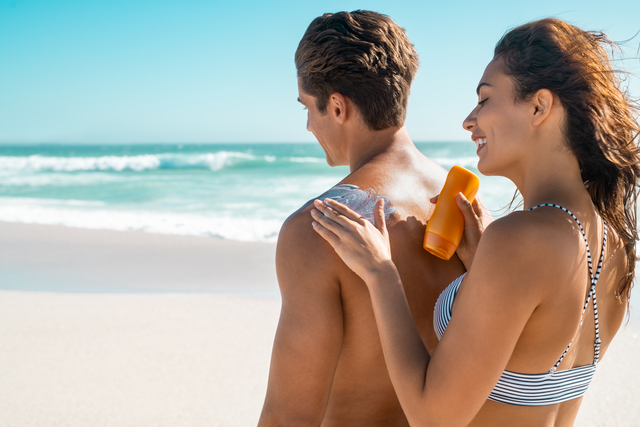The subject of sunscreens has long been controversial. Cosmetics market is enriched with new ‘sunprotect’ products every year – but what do we really know about this type of creams? The feature that all preparations dedicated to skin exposed to sunlight have in common is the fact that they are a type of protective barrier against ultraviolet radiation for our skin. Warning! They only work for a limited time after being applied. UV filters have different finishes – they are absorbed into the skin without leaving a trace or create a visible, white layer. When choosing a cream, it is worth taking care of the water resistance of the cosmetic – after a water bath, the filters can be washed off – and our skin is defenseless. After hours spent carelessly in the sun, the skin may turn red. Redness often takes the form of irritation. To avoid such consequences, it is worth finding out what sunscreens are, what processes they prevent in our skin, whether there is a difference in their action, and which products are better to avoid.
UV radiation – basic information
The group of dangerous side effects of exposure to UV rays on the skin includes; skin cancer, faster photoaging, oxidative stress.
A distinction should be made here between two types of radiation:
UVA and UVB. UVA radiation is stronger – it can penetrate, for example, through glass and clouds, it even reaches the proper layer of the skin. Due to its length, it causes more serious damage than UVB, where long-term sun exposure results, among others, in oxidative stress. What does this mean in practice? The structure of the body’s cells (including elastin and collagen) is destroyed.
An additional danger is the so-called delayed erythema. He is responsible for the process of the formation of unsightly freckles, hypo- or hyperpigmentation, and sometimes can lead to photoallergic reactions. The advantage of UVA rays is the effect on the production of melanin (change in the color of the epidermis).
UVB rays are inhibited by weather conditions and reach the basal layer of the epidermis. Despite its lower penetration capacity, it is more toxic to our skin. Lack of protection against this type of radiation with prolonged exposure reduces immunity and reduces the amount of hyaluronic acid.
In terms of the positive effects of UVB radiation – it affects the cycle of vitamin D metabolism. It leads to the production of the active form of vitamin D – calcitriol in the kidneys. It is she, among others. prevents depression and mood disorders, ensures proper development and functioning of the body, protects children against rickets, and the elderly against osteoporosis. Interestingly, research confirms that the right dose of UV radiation increases our tolerance to skin grafts, reduces the effects of AD, seborrhea, and psoriasis.
How to choose filters?
The human race is his natural sun protection. In our latitude, two races predominate: Celtic and Caucasian. What are they characterized by? Celtic: People with red or blonde hair and very fair skin. Due to the increased risk of erythema – they should apply UV filters with the highest available protection level.
People from the Caucasian group are certainly lucky – they immediately gain a golden-brown shade of tan when tanning.
Due to the fact that our natural protection, unfortunately, is not a sufficient measure to fight UV radiation, we must use properly selected filters. Effective sunscreen products should be characterized by; water resistance, photo stability, non-toxicity, and above all, no tendency to cause photosensitizing, photoallergic and carcinogenic reactions.
To check what UV filters are dedicated to our skin, it is worth conducting an experiment. For this purpose, it should be observed how long after the first minutes of exposure to the sun the skin becomes red. This is called minimum erythematous dose. If the reaction took place after 5 minutes, and we want to use a 20 filter – we could safely spend a total of 100 minutes in the sun. In theory, this is the result of multiplying the time and the filter height. Each skin reacts differently, to ensure maximum safety, it is recommended to divide the theoretical sun exposure time by 4.
We divide UV filters into physical and chemical. The first have the effect of reflecting or diffusing sunlight. The other one absorbs radiation. Physical (so-called inorganic) protect our skin against both UVA and UVB radiation. Chemical (organic) filters are divided into different types – but not all of them protect us from UVA and UVB radiation.
Inorganic are divided into
– color pigments – reflect visible light and it is they that leave a white layer on the skin (which makes them one of the safest preparations)
– micronized pigments – the effect of micronized particles allows you to avoid the unsightly appearance of whitening without losing the optimal filter power.
When choosing organic filters, you should pay attention to their wide spectrum of action (avoid its lack) – from this group only filters with a broad spectrum of action effectively protect the skin against UVA and UVB radiation.
In turn, the advantage of the most modern chemical filters is water insolubility, which allows for an extended period of their operation.
If you want to tan in a way that is 100% safe for the skin – learn more about spray tanning.
You can make an appointment using a convenient 24/7 form!
Eco-Filters
For lovers of natural care – cosmetic companies have created UV filters containing extracts of natural origin. Some plant extracts can absorb ultraviolet radiation. Photoprotective extracts include: Helichrysum inflorescence, chamomile, rhizome and Baikal skullcap root, green tea leaves, bee putty, aloe extract, shea butter, cocoa butter, argan oil, macadamia, sesame, avocado, long pepper, saffron. They have a positive effect on the condition of the skin, reduce the negative effects of photoaging and at the same time fight free radicals.
UV filters protect our skin, among others against burns. The sunscreen must be applied about 15 minutes before leaving the house (sunbathing). The cream should be in our handy cosmetic bag because you must repeat the application after 2-3 hours. After water baths, the filter should also be applied (even if it is waterproof – there is a risk of insufficient protection against burns). To enjoy a beautiful, healthy tan – you need to responsibly choose the type of SPF, both for your phototype and individual reaction to radiation. Due to the popularity of this type of preparations (especially in the summer season), everyone can find the perfect cream for themselves.








